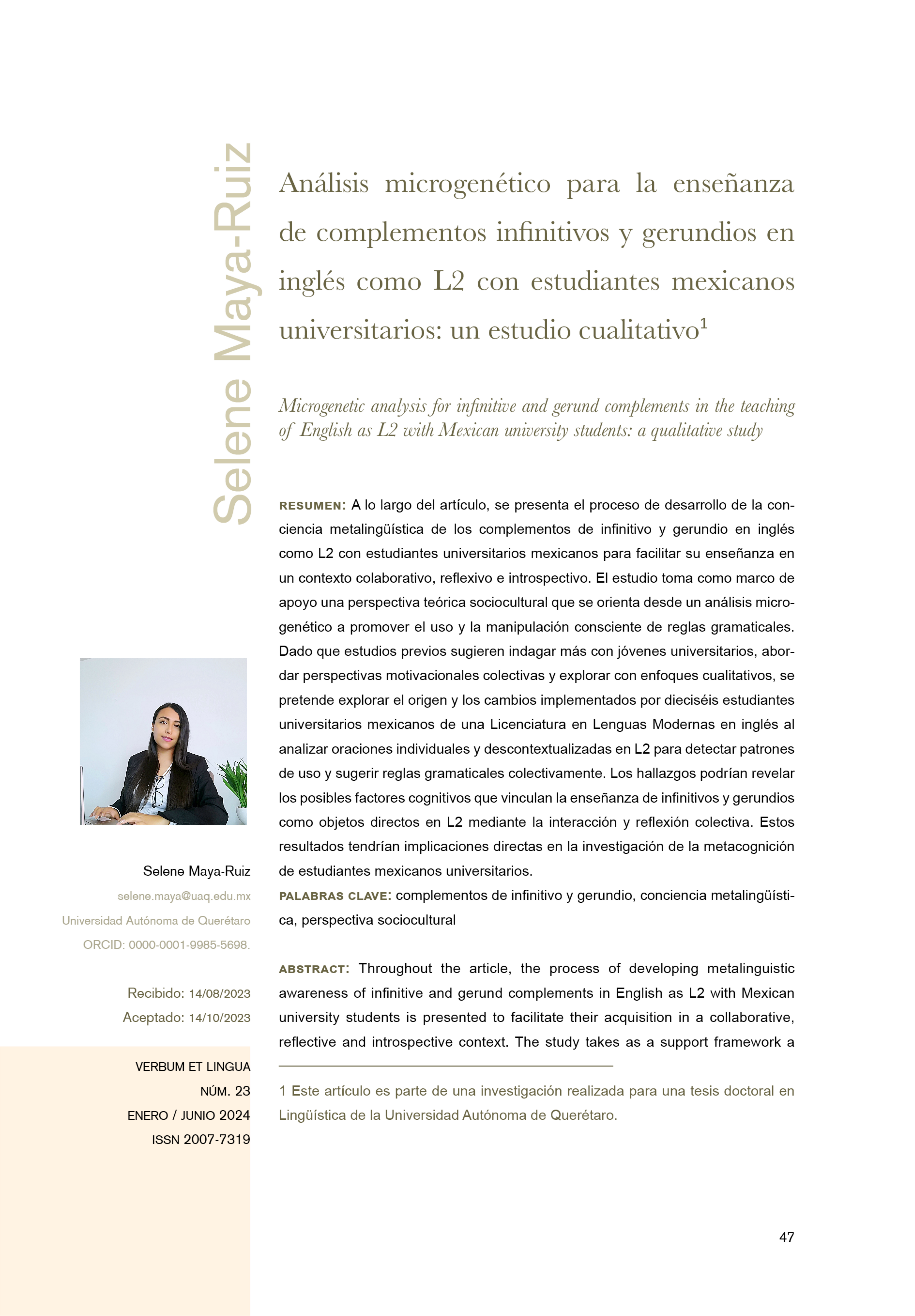Análisis microgenético para la enseñanza de complementos infinitivos y gerundios en inglés como L2 con estudiantes mexicanos universitarios: un estudio cualitativo
DOI:
https://doi.org/10.32870/vel.vi23.230Parole chiave:
complementos de infinitivo y gerundio, gerundio, consciencia metalingüística, perspectiva socioculturalAbstract
Resumen: A lo largo del artículo, se presenta el proceso de desarrollo de la conciencia metalingüística de los complementos de infinitivo y gerundio en inglés como L2 con estudiantes universitarios mexicanos para facilitar su enseñanza en un contexto colaborativo, reflexivo e introspectivo. El estudio toma como marco de apoyo una perspectiva teórica sociocultural que se orienta desde un análisis microgenético a promover el uso y la manipulación consciente de reglas gramaticales. Dado que estudios previos sugieren indagar más con jóvenes universitarios, abordar perspectivas motivacionales colectivas y explorar con enfoques cualitativos, se pretende explorar el origen y los cambios implementados por dieciséis estudiantes universitarios mexicanos de una Licenciatura en Lenguas Modernas en inglés al analizar oraciones individuales y descontextualizadas en L2 para detectar patrones de uso y sugerir reglas gramaticales colectivamente. Los hallazgos podrían revelar los posibles factores cognitivos que vinculan la enseñanza de infinitivos y gerundios como objetos directos en L2 mediante la interacción y reflexión colectiva. Estos resultados tendrían implicaciones directas en la investigación de la metacognición de estudiantes mexicanos universitarios.
Downloads
Metriche
Riferimenti bibliografici
Al-Gburi, M. B. (2019). The Effective Ways and Methods of Teaching the Differences between Infinitives and Gerunds. Dirasat Tarbawiya, 12(48).
Altman, C., Goldstein, T., & Armon-Lotem, S. (2018). Vocabulary, metalinguistic awareness and language dominance among bilingual preschool children. Frontiers in Psychology, 9(OCT), 1–16. https://doi.org/10.3389/fpsyg.2018.01953
Barrios, Alia, Barbato, Silviane, & Branco, Angela. (2012). El análisis microgenético para el estudio del desarrollo moral: consideraciones teóricas y metodológicas. Revista de Psicología (PUCP), 30(2), 249-279. Recuperado en 05 de diciembre de 2021, de http://www.scielo.org.pe/scielo.php?script=sci_arttext&pid=S0254-92472012000200002&lng=es&tlng=es.
Bialystok, E., Peets, K.F., & and Moreno, S. (2014). Producing bilinguals through immersion education: Development of metalinguistic awareness. Applied. Psycholinguistics. 35,177–191.
Chalabian, F. (2020). ESL textbooks materials and real language use: Comparing corpus-based materials and textbook materials on gerunds/infinitives (Doctoral dissertation, Carleton University).
D’Angelo, F., & Sorace, A. (2022). The additive effect of metalinguistic awareness in third or additional language acquisition. International Journal of Bilingual Education and Bilingualism, 25(10), 3551-3567.
Ellis, R. y N. Shintani. (2014). Exploring Language Pedagogy through Second Language Acquisition Research. London: Routledge.
Fotos, S. S. (1994). Integrating grammar instruction and communicative language use through grammar consciousness?raising tasks. TESOL quarterly, 28(2), 323-351.
Gánem-Gutiérrez, G. A. (2016). Enhancing metalinguistic knowledge: Preterite and imperfect in L2 Spanish. Language and Sociocultural Theory, 3(1), 27–54. https://doi.org/10.1558/lst.v3i1.28803
Harun, H., Abdullah, N., Wahab, N. S. A., & Zainuddin, N. (2017). The use of metalanguage among second language learners to mediate L2 grammar learning. Malaysian Journal of Learning and Instruction, 14(2), 85–114. https://doi.org/10.32890/mjli2017.14.2.4
Kieseier, T., Thoma, D., Vogelbacher, M., & Holger, H. (2022). Differential effects of metalinguistic awareness components in early foreign language acquisition of English vocabulary and grammar. Language awareness, 31(4), 495-514.
Lantolf, J. P. (2008). ‘Praxis and classroom L2 development.’ Estudios de lingüística inglesa aplicada 8: 13-44.
Naqvi, R., Thorne, K., McKeough, A., & Pfitscher, C. (2010). Building bridges: Acknowledging children’s first languages: Final report May 2010.
Negueruela, E. (2008). ‘Revolutionary pedagogies: learning that leads (to) second language development’ in Lantolf J. P. and M. E. Poehner (eds.): Sociocultural Theory and the Teaching of Second Languages (pp. 189-227). Equinox, London.
Pao, M. (2020). Communicating in the Face of Racism: Infinitive v. Gerund Verbal Complements in English. GATESOL Journal, 30(1), 80-90.
Ramirez, G., Walton, P., and Roberts, W. (2013). Morphological awareness and vocabulary development among kindergarteners with different ability levels. J. Learn. Disabil. 47(1), 54—64. doi: 10.1177/0022219413509970
Rossetti-Ferreira, M. C.; Amorim, K. S.; Soares-Silva, A. P. & Oliveira, Z. M. R. (2008). Desafios metodológicos na perspectiva da rede de significações. Cuadernos de Pesquisa, 38(133), 147-170.
Sampson, A. E. (2019). Languaging and learning compared across EFL course delivery modes. (Doctoral dissertation, Lancaster University, United Kingdom).
Tjabaka-Mokapane, L. (2023). Categorial Conflict between Phrasal-Prepositional Verbs and Infinitives: The Great Complement Shift. Elsya: Journal of English Language Studies, 5(2), 159-172.
Tunmer, W. E., & Herriman, M. L. (1984). The development of metalinguistic awareness: A conceptual overview. Metalinguistic awareness in children: Theory, research, and implications, 12-35.
Vygotsky, L. S. (1987). The Collected Works of L. S. Vygotsky: Vol. 1. Problems of General Psychology. Including the Volume Thinking and Speech. Reiber, R.W. and A.S. Carton (eds.). Plenum, New York.

Downloads
Pubblicato
Versioni
- 2024-08-23 (3)
- 2024-08-23 (2)
- 2024-03-08 (1)












